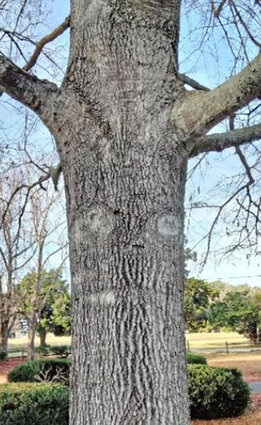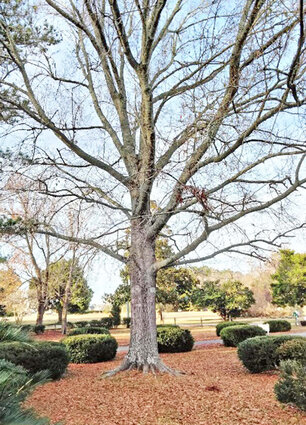Random Thoughts
March 20, 2024
THE GHOST OAK
In 2017 with our youngest daughter graduating from high school, and the corporation I worked for being simultaneously acquired by a larger firm, my wife suggested we make yet another move. After 13 years in Colorado, she wanted someplace wetter, greener, and warmer. We ultimately settled in a home outside New Bern, North Carolina that met both my bride’s and my prerequisites; hers as previously stated, and mine being near a military base, a home on a single level meaning no stairs, and the garage must absolutely be side entry and not seen from the street. We found what we were looking for outside the Colonial Capital of North Carolina and just beyond the gates of Marine Corps Base – Cherry Point.
The house we ultimately purchased was everything we hoped for in our ‘forever’ home. A large lot with room for a vegetable garden, on the water including a dock, and what was especially satisfying was the history of the place.
Major General Paul Fontana (https://www.arlingtoncemetery.net/pfontana.htm), a Marine Corps fighter pilot from WWII and former commander of the nearby Marine Corps base built what would become our home upon his retirement from the military in 1972. You may read about his exploits in the Pacific Theater of operations during World War II. Interestingly, General Fontana commanded Marine Fighter Squadron 112 in the Pacific. The Squadron was known as the ‘Wolfpack.’ That was a particularly interesting anecdote as I commanded B Company, 1st Battalion, 16th Infantry Regiment during Desert Storm. We were also known as the Wolfpack because you couldn’t just fight one of us, you had to fight us all. Apparently, General Fontana and I shared the same command philosophy.
I also learned that New Bern is rich in Colonial and Civil War history. New Bern was the Colonial Capital of North Carolina, and British Lieutenant-General William Tryon served as governor from 1764 to 1771. He administered the colony from Tryon Palace. Governor Tryon was the last British Colonial Governor appointed by the King.
Later, George Washington visited New Bern and the Tryon Palace in April 1791. He had been elected President only two years before in February 1789, and North Carolina had become part of the Union in November of the same year. Washington stayed two nights in New Bern as part of his southern tour, and the Palace was used for a fancy ball in the same room that the British Colonial Governor Tryon had once ruled.
During the Civil War, on March the 13, 1862, 11,000 Union troops led by General Ambrose Burnside landed at nearby Slocum's Creek in their effort to capture the town of New. The fierce battle in the swamps and along the railroad five miles south of New Bern on March 14, 1862, proved to be a major victory for the Union and led to the ensuing occupation of New Bern for the remainder of the Civil War. Estimated casualties for the battle were about 1080 total, and our home is located near the battlefield. The Battle of New Bern was the baptism of fire for the 26th North Carolina. Later, in July 1863, the 26th lost 588 of 800 men at the battle of Gettysburg — sustaining the largest numerical losses of any unit, North or South, during the entire course of the war.
More to the point, this property or rather the plantation 15 miles south of New Bern, then known as the Magnolia Plantation, traced its origins back to the original owner John Lovick who purchased approximately 2,000 acres in 1719. The Lovick’s lived in a grand mansion that was burned down by Union troops as they advanced toward battle in March 1862. The brick remains of that colonial home can be seen to this day. The name of the plantation was obviously derived from the large number of magnolia trees that are present on the property. Our front yard has four of these behemoths that are a couple hundred years old. The most striking natural phenomenon on our land, however; is the ‘ghost oak’ that stands as a silent sentinel guarding the entrance to our home.
I have attached pictures of the 70+ foot tall Ghost Oak as we call it and have speculated that a playful child with a pocketknife carved the eyes, nose, and mouth on this massive oak tree that stands facing the main entrance of our home. Equally possible is that a bored Confederate cavalry soldier posted on the Magnolia Plantation prior to the Union’s invasion whittled the face clearly seen in the photo. The historical significance of our property is never far from sight. The nearby Lovick family cemetery where gravestones dating from the Revolutionary War remind all of Magnolia Plantation’s past in the place we now call home.
This tree has been through quite a few hurricanes and it is still standing strong. It did suffer slight damage from Hurricane Florence in 2018, but it continues growing and growing. We honestly do not know if this tree ever had a proper name, nevertheless we have attached the Ghost Oak moniker to it. That said, we consider the tree to be inhabited by a friendly ghost that protects rather than haunts our home. With care and occasional pruning, it is very likely that the Ghost Oak we inherited from the Lovick family and General Fontana will also prove interesting to the families that follow providing them with shade, shelter, and mystery well into the next century.




Reader Comments(0)